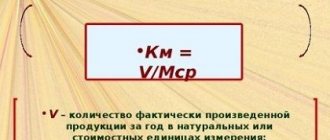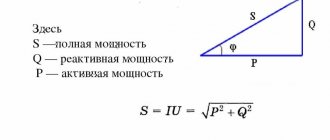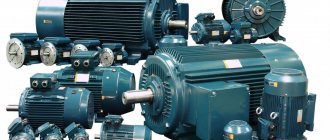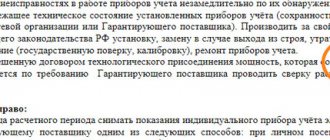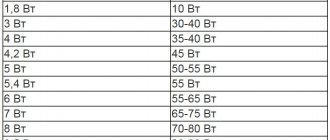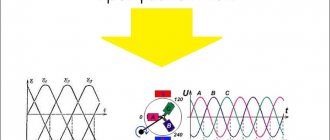Nominal speed
Another key indicator of the electromechanical characteristics of the engine is the shaft speed. It is expressed in revolutions per minute. It is often used in the pump motor power formula to find out its performance. But it must be remembered that the indicator is always different for idling and operation under load. The indicator represents a physical quantity equal to the number of full revolutions over a certain period of time.
Calculation formula for speed:
n = 30 × omega ÷ pi, where:
n — engine speed, rpm.
In order to find the power of an electric motor using the shaft speed formula, it is necessary to reduce it to the calculation of angular velocity. Therefore P = M × omega will look like this:
P = M × (2pi × n ÷ 60) = M × (n ÷ 9.55), where
t = 60 seconds.
What is it and how to calculate the load
Electric current load is a quantity characterizing its properties. Shows how much energy is consumed by electrical appliances. The current power is measured using a special device - a wattmeter.
If you connect a meter in series, you can check the current strength. When connecting in parallel, the voltage is determined. The amount of circuit consumption is calculated using the formulas: P = I x U or P = U2/ R = I2 x R.
The electrical load is equal to the voltage across the consumer multiplied by the amount of current flowing through it.
P = U x I
The formula indicates which measurements determine this parameter. If the load is active, it is measured in Watts, the reactive unit of electrical power is VA.
Power via engine displacement
It is not always possible to determine the engine torque. Sometimes car owners do not even know the meaning of this parameter. In this case, the power of the engine unit can be determined using the engine volume.
To do this, you will need to multiply the volume of the unit by the crankshaft speed, as well as by the average effective pressure. The resulting value must be divided by 120:
P = (V * n * Peffective)/120 where V – engine volume, n – crankshaft rotation speed [rpm], Peffective – average effective pressure, 120 – constant, proportionality coefficient.
This is how the power of a car engine is calculated using the volume of the unit.
Most often, the Peffective value in standard gasoline engines varies from 0.82 MPa to 0.85 MPa, in forced engines - 0.9 MPa, and in diesel units the pressure value ranges from 0.9 MPa to 2.5 MPa.
When using this formula to calculate the actual power of the motor, to convert kW to hp. s., it is necessary to divide the resulting value by a coefficient equal to 0.735.
This calculation method is also far from the most complicated and takes a minimum of time and effort.
Using this method, you can calculate the power of the pump motor.
What is power in electricity
Voltage is the work done to move a unit of charge. Current is the number of coulombs moved in 1 second. When multiplying the first parameter by the second, the total amount of work done in 1 second is obtained.
The strength of electricity is a numerical current meter that characterizes its energy qualities. The power indicator equally depends on voltage and current strength. How is current power measured? To measure this parameter, a Wattmeter is used; the unit of measurement is designated in the same way - W (Watt).
By using the dependence of the power parameter on current and voltage, specialists can transmit electricity over long distances. For these purposes, energy is converted at step-down and step-up transformer substations (transformer substations).
Current power through the capacitor
Let an alternating voltage be applied to the capacitor. As we know, the current through a capacitor is ahead of the voltage in phase by:
For instantaneous power we get:
A graph of instantaneous power versus time is shown in Fig. 3.
Rice. 3. AC power through capacitor
What is the average power value? It corresponds to the “middle” of the sinusoid and in this case is equal to zero! We see this now as a mathematical fact. But it would be interesting to understand from a physical point of view why the current power through the capacitor turns out to be zero.
To do this, let's draw graphs of voltage and current in the capacitor over one oscillation period (Fig. 4).
Rice. 4. Voltage across the capacitor and current through it
Let's consider all four quarters of the period sequentially.
1. First quarter
, . The tension is positive and increasing. The current is positive (flows in the positive direction), the capacitor is charged. As the charge on the capacitor increases, the current decreases.
Instantaneous power is positive: the capacitor stores energy coming from the external circuit. This energy arises due to the work of an external electric field that pushes charges onto the capacitor.
2. Second quarter
, . The tension remains positive, but is subsiding. The current changes direction and becomes negative: the capacitor is discharged against the direction of the external electric field. At the end of the second quarter, the capacitor is completely discharged.
Instantaneous power is negative: the capacitor releases energy. This energy returns to the circuit: it is used to do work against the electric field of the external circuit (the capacitor, as it were, “pushes” the charges in the direction opposite to the one in which the external field “wants” to move them).
3. Third quarter
, . The external electric field changes direction: the voltage is negative and increases in magnitude. The current is negative: the capacitor is charging in the negative direction.
The situation is completely similar to the first quarter, only the signs of voltage and current are opposite. The power is positive: the capacitor again stores energy.
4. Fourth quarter
, . The voltage is negative and decreases in magnitude. The capacitor is discharged against the external field: the current strength is positive.
Power is negative: the capacitor returns energy to the circuit. The situation is similar to the second quarter - again with the replacement by replacing the signs of current and voltage with opposite ones.
We see that the energy taken by the capacitor from the external circuit during the first quarter of the oscillation period is completely returned to the circuit during the second quarter. This process is then repeated again and again. This is why the average power consumed by a capacitor turns out to be zero.
Power power
To solve practical problems, change the considered expressions as necessary. Calculation of energy changes shows an example with a falling object:
- in the initial data, the height and weight of the body are known;
- you need to set the power of the force, the formula of which displays the result halfway through free fall;
- substitute known quantities for the basic components:
- F = m *g;
- V (velocity at a certain point) = Vn (initial velocity) + g*t.
- after the transformation is completed, you get:
P = m*√(g3*h).
Formulas for measurement
Power is a quantity that is directly related to other indicators. Thus, it is directly related to time, force, speed, force vector and speed, force and speed modulus, torque and rotation frequency. Often, in formulas when calculating the electrical power type, the number Pi, the resistance indicator, instantaneous current with voltage in a specific section of the electrical network, active, total and reactive power are also used. A direct participant in the calculation is the amplitude with angular velocity and the initial current strength with voltage.
In the calculations of the hydraulic power type, pressure and fluid flow take part. Often the number of engine revolutions for a specific period of time is taken into account.
Additional Information! To calculate thrust, efficiency with other operating parameters of the device, temperature, friction force and conductive resistance with reactive loads are studied.
Basic formulas for measurement
What is it measured in?
The unit of measurement of electrical power is W for Russia. By international standards - W. This is the energy provided per unit of time. One W is equal to a joule per second (J/s). Moreover, a joule is a unit of electrical power, a second is a unit of time.
For small values, multiple prefixes are used: “milli-”, “micro-”, for large values - “mega-”. For example: 5,800 W = 5.8 kilowatts = 5.8 kW.
When you multiply 1 Kilowatt by 1 hour, you get a Kilowatt-hour (kW x h). This is a unit of measurement of the amount of electricity provided to subscribers. It is used by energy enterprises that own the appropriate equipment (generators and transformer substations). They generate and convert the produced electricity, which is then distributed to consumers.
In the same way, the energy capacity of batteries is measured in units of ampere hours (Ah). Portable types of energy storage batteries are measured in milliampere hours (mAh).
For the unit of measurement Watt, according to international standards, the letter designation W is allocated after James Watt. He was the first to use the term “horsepower,” which today is an obsolete unit of the W parameter.
Energy conversion indicators:
- horsepower (HP) - 746 W;
- kilo Watts (kW) – 1×1000 W;
- megawatts (MW) −1×1000000 W;
- gigawatt (GW) – 1×1000000000 W.
Today, "horsepower" is used to indicate the second measure of engine power in vehicles.
Electric power
In this area, the weight of objects, frictional force, and other mechanical terms and definitions are not important. However, the essence of the physical quantity under consideration remains unchanged, the principles of individual calculations are similar.
You can use the formula to calculate instantaneous power:
Where:
- (ab) – denote the energy expended on moving charge (q) from one point to another;
- A is the work performed during this process.
If we take all the charges (Q), the voltage at the control points (U), it is easy to calculate the total power:
P = (U/ Δt) * Q = U * Q/ Δt = U *I.
The last transformation is based on the classical definition of current (the number of charges flowing through the corresponding conductor in a certain time).
For passive circuits, you can use Ohm's law and the corresponding formulas without additional corrections. Take into account (if available) the source of electromotive force (direction of current movement).
When connecting equipment to AC sources, calculations become more complicated. It is necessary to integrate instantaneous values taking into account certain periods, frequencies and waveforms. In practice, they often solve problems of calculating the power of consumers connected to a power source with a sinusoidal current (voltage).
The active component of energy in this case will depend on the phase shift. The value is calculated using the formula:
Pa = U * I * cosϕ (for 220V).
When working with three-phase sources, use a modified version of the expression:
Pa = √3 * U * I * cosϕ = 1.732 * U * I * cosϕ.
The reactive variable is consumed and returned to the power supply. For the calculation, take the following dependence of the basic parameters:
Full power:

